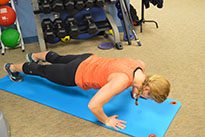What is Functional Exercise?
Chances are, if you find yourself flipping through a Journal of the Spinal Research Foundation, you or someone you love has been struggling with back pain and its various symptoms for quite some time now. And if you are like most patients when they first walk through the door of a physical therapist’s office, you have already been given so many exercises by various practitioners that you have a stack of papers an inch thick with no idea which ones you should do, so you either….
A.) Do every exercise everyday (making them seem like a full time job)
B.) Pick the exercises you can do best and continue doing those until you are given more by someone else
C.) Ignore them and go back to your own training regimen
D.) Give up on prescribed exercises and all other exercise completely, because any exercise seems to produce pain
If you fit in to any of the above-mentioned categories (whether you have had spinal surgery or not), there is a good probability that your pain will continue until your body begins to deviate from its problematic motor patterns (pain postures). Specific strength exercises (i.e. clamshells) can help strengthen weak muscles (gluteal muscles). However, unless you learn how to apply the strength gains to better postural movements (functional exercise), your body will continue to experience pain. When the posture in which you move is at the root of your pain, addressing pain postures before surgery is extremely helpful for a quicker recovery. Returning functional movement to the patient as soon as possible after surgery is equally as important for long-term success.
As we age, injuries occur to the spine and other parts of the body (minor and major), causing structures within the body to start breaking down. Whether from injury, weakness, stiffness, or even hypermobility, these assaults slowly start to affect the way we move by causing minor compensations that can cause major problems over time. An understanding and implementation of functional exercise can be very useful in identifying these improper movement patterns and help correct them through thought-invoking exercises, as well as posture and movement retraining. Without proper retraining of the body and the postures we encounter every day, those same improper patterns you had before surgery can come back to haunt you.
To introduce the importance of functional exercise, let’s use an example of a bridge over a bay:
Let’s say there is a bridge that was perfectly constructed. Every brick, beam, and concrete slab of the bridge was put meticulously into place many years ago, creating a beautifully efficient highway across the bay. But over time, the bridge starts to show signs of aging (much like an aging spine). The ground beneath it (posture) starts to erode slowly, while the heavy traffic offers its own battery of assault from above. Every week, accidents occur (both major and minor), temperatures fluctuate, and storms batter the bridge over the years until there is a need for a traffic halting repair (much like when a patient alters his/her life for surgery). Now, since this bridge is so important to the communities it supports, they bring in the best bridge repair team in the area to fix the structure. After weeks of construction, the bridge looks like new and opens for business. But after a short time passes, the bridge begins to show the same signs of disrepair it had before the massive re-build, only fifty feet from the original repair site. As it turned out, a major item had been overlooked. The erosion of the ground beneath (posture) had not been properly dealt with. The communities were shocked to learn that the erosion repairs were just as important as the structural repairs, and had they been addressed together from the beginning of the project, they would have produced a much better end result rather than resulting in another re-build.
This scenario is similar to that of many spinal surgery patients. Without the proper guidance from your medical support team, coupled with groundwork (posture exercises) being done vigilantly by the patient to support the newly renovated structure, the same structural defects can continue to cause pain down the road. However, with trained professionals helping you along the way and your own hard work on postural retraining and functional exercise, you can break the pain cycle and take control of your recovery and quality of life for years to come. So that leads us to the question at hand…
What is Functional Exercise?
Functional Exercise is the training of the body for the activities performed in daily life.
By definition, everyone has the capability to do functional exercise. Just think about your day-to-day life and you can see where the six basic functions of movement (squat, hinge, lunge, push, pull, carry) stem from. These basic human functions can be surprisingly difficult for someone out of touch with his or her neutral posture and suffering from pain. Simple tasks such as rolling over to get out of bed or even getting out of your car can trigger painful, yet seemingly unpredictable muscle spasms. The main goal of functional exercise is to produce normal everyday tasks while maintaining a neutral spine. In case you hadn’t heard that term before, neutral spine is a term used to describe a spinal position with no imposed flexion, extension, or rotation. It should also be a posture that every one of us should not only be familiar with but should be able to recreate, no matter what position we find ourselves in throughout the day. After all, our hips, knees, and ankles are where we were designed to bend from. While you may not notice when you are bending your back too much, your back is smarter than even you sometimes. If you have no idea what position your spine should be in, then it will start telling you to stop, by way of pain. Slowly but surely, your spine will start shutting down ranges in movements that it does not feel safe in and if you continue to not to listen, the pain will shut you down completely. When kept out of proper neutral alignment for too long, surgery becomes a necessity and learning neutral posture becomes harder to learn, yet still possible.
You see, without the knowledge of where your correct neutral posture should be, it can quickly get lost completely and the pain postures start shoving their way in, making your daily life miserably restricted.

Carrie Seifert, CSCS
Virginia Therapy & Fitness Center



